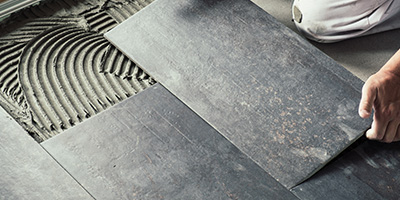Experience Quality: Premier Tile Installation Austin Services
Experience Quality: Premier Tile Installation Austin Services
Blog Article
Discover the Keys to Perfect Ceramic Tile Installation Every Time
Attaining flawless ceramic tile installment might look like a difficult job, usually bring about frustration and imperfections that detract from the total visual. Grasping the art of tile installation includes a series of specific actions and methods that, when executed appropriately, can result in a refined and smooth surface. From surface area prep work to cement application, each stage plays an important function in the final result of your job. By understanding the tricks behind each step, you can guarantee that your tile installment not just fulfills yet surpasses your expectations.
Correct Surface Preparation
Effective floor tile installment hinges dramatically on thorough surface prep work to make sure a flawless result. Prior to laying tiles, it is important to assess the substrate's condition completely. The surface area needs to be tidy, dry, and structurally seem to avoid future concerns such as loose ceramic tiles or fractured cement. Any type of existing floor covering product, adhesives, or sealers need to be removed to develop a consistent base for the new tiles.
To guarantee proper adhesion, it is suggested to roughen smooth surfaces with sanding or scarifying. Furthermore, applying a primer can enhance bonding between the tile and the substrate adhesive. Uneven surface areas ought to be leveled using a self-leveling substance to avoid lippage and guarantee a smooth surface.
In addition, examining for prospective sources of moisture is important, as excess wetness can lead to mold and mildew development and damages the ceramic tiles in time. Using a dampness obstacle or waterproofing membrane layer in wet areas like cooking areas or shower rooms is vital to secure the ceramic tiles from water damages. By thoroughly preparing the surface area before floor tile setup, one can develop a visually attractive and long lasting tiled area that will certainly stand the test of time.

Choosing the Right Adhesive
Choosing the appropriate adhesive is a critical action in ensuring the successful installment of ceramic tiles. The sort of glue you pick will rely on various variables such as the kind of tile, the substratum product, and the place of the installation. There are various types of adhesives available in the marketplace, consisting of thin-set mortar, mastic, and epoxy.

Epoxy adhesives are exceptionally long lasting and water-resistant, making them perfect for areas vulnerable to moisture such as cooking areas or bathrooms. read this article They are additionally appropriate for installing glass or steel tiles. When selecting an adhesive, make certain to follow the maker's recommendations and think about the particular needs of your tile installment project.
Precision Reducing Techniques
One of the most typical devices made use of for accuracy cutting in floor tile installment is the floor tile cutter. Tile cutters come in various types, consisting of hand-operated ceramic tile cutters, electrical wet saws, and handheld ceramic tile cutters. Hands-on ceramic tile cutters are suitable for straight cuts on ceramic and porcelain tiles, giving exact and tidy edges.
In addition, making use of a floor tile nipper allows for detailed cuts and forming around barriers or uneven forms. Wet tile saws geared up with ruby blades are excellent for making bent cuts, intermediaries for fixtures, or complex designs. In addition, making use of tools like tile scribes or glass cutters can help in racking up and snapping tiles with precision. By understanding these precision cutting strategies, floor tile installers can make sure an expert surface and a visually appealing lead to their ceramic tile projects.

Grout Application Tips
When transitioning from precision cutting techniques to grout application in ceramic tile setup, attention to detail and technique is extremely important for achieving website here a remarkable coating. Cement serves not just as a useful component that fills up the spaces between floor tiles yet additionally plays a considerable function in the overall visual of the setup. To guarantee a successful cement application, start by selecting the proper kind and color of grout that complements the floor tiles. Mix the cement according to the manufacturer's guidelines, making certain a lump-free and smooth consistency.
When the cement is applied, utilize a wet sponge to clean the tiles, making sure not to eliminate cement from the joints. Adhering to these cement application tips will certainly result in an expertly set up ceramic tile surface area that boosts the appeal of any space.
Completing Touches and Maintenance
To finish the floor tile setup job efficiently, attention to information throughout the completing touches and regular upkeep is crucial. After the cement has actually dried out and the tiles are firmly in location, the final steps entail making certain that all sides are correctly secured.
Routine maintenance is vital to protecting the beauty and capability of your tiled surface areas. An easy regimen of sweeping or vacuuming complied with by mopping with a mild cleaner can help maintain your tiles looking immaculate (tile installation browse around here austin). For locations that are frequently exposed to wetness, such as restrooms or kitchens, normal resealing of grout lines is recommended to protect against mold and mildew and mold development
Conclusion
To conclude, achieving excellent ceramic tile installment each time calls for interest to information and proper strategies. By focusing on surface area prep work, choosing the right adhesive, making use of precision cutting techniques, using cement thoroughly, and completing with focus to information, you can guarantee a professional-looking result. Remember to follow these actions and maintain your tiles consistently to prolong their life expectancy and maintain them looking their finest.
One of the most usual tools utilized for precision cutting in ceramic tile setup is the ceramic tile cutter. Ceramic tile cutters come in numerous kinds, consisting of hand-operated ceramic tile cutters, electrical wet saws, and handheld ceramic tile cutters. Hands-on ceramic tile cutters are appropriate for straight cuts on ceramic and porcelain tiles, supplying tidy and precise edges. In addition, making use of devices like floor tile scribes or glass cutters can assist in racking up and breaking tiles with precision. By mastering these precision cutting methods, ceramic tile installers can guarantee an expert surface and a visually enticing outcome in their tile tasks.
Report this page